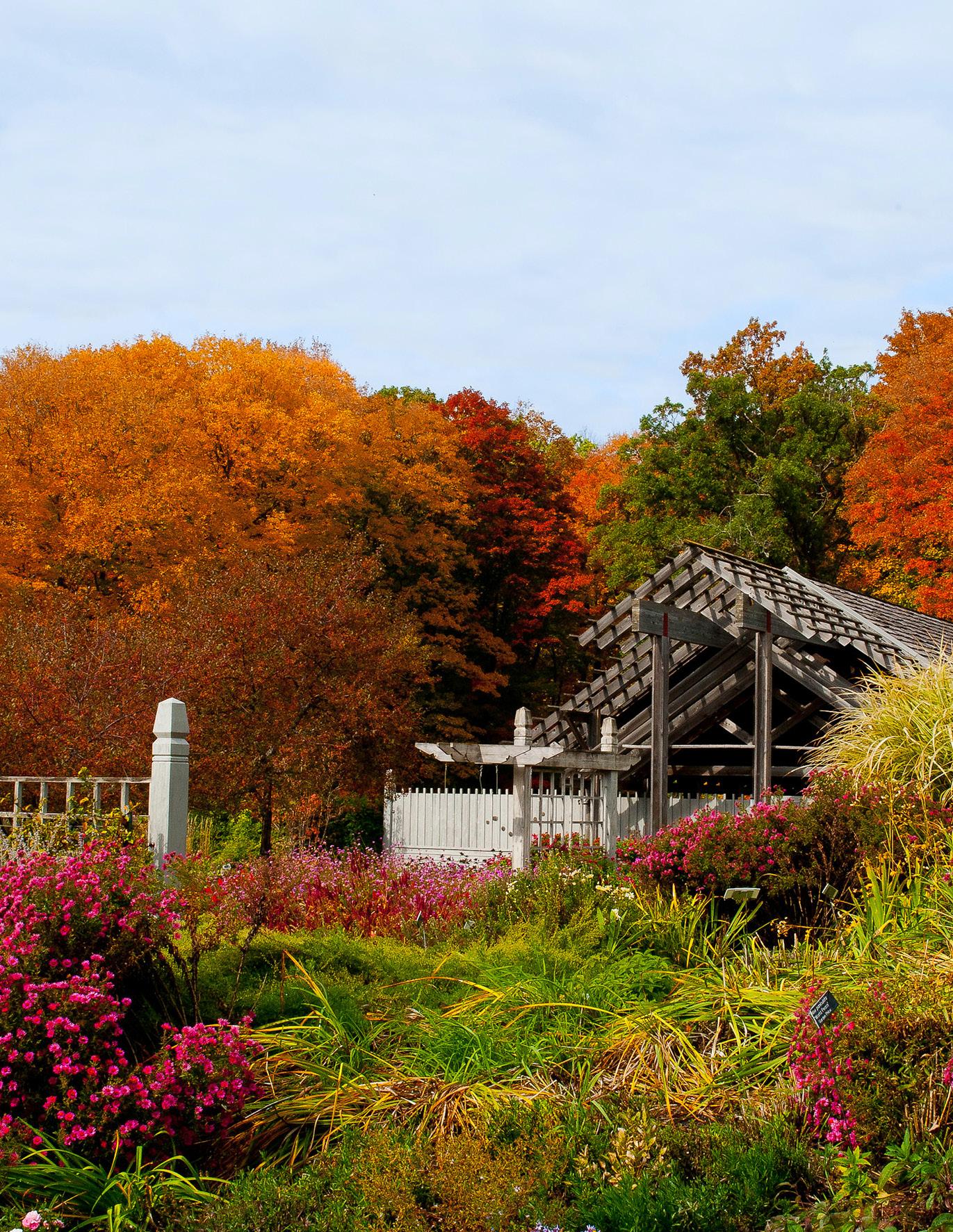
arboretum magazine OCTOBER/NOVEMBER 2023 Explore the Arboretum’s amazing fall foliage!
FROM THE EXECUTIVE DIRECTOR
ANDREW GAPINSKI
Reds, oranges and yellows have just begun to color trees across the Arboretum grounds, and the full splendor of autumn is still ahead! With the incredible diversity of tree species represented in our collections, I can’t wait to see the Arboretum transformed with the changing season. Be sure to plan a visit to view the fall foliage, as well as the pumpkin displays that enhance the Dahlberg Terrace and surrounding gardens. The Horticultural Research Center’s John and Jenny Thull — viticulturists by day — have a passion for selecting and growing the more than 350 varieties of Cucurbita (pumpkins, squash and gourds) that you’ll see decorating the Arboretum in October. Learn more about the unique varieties they’ve
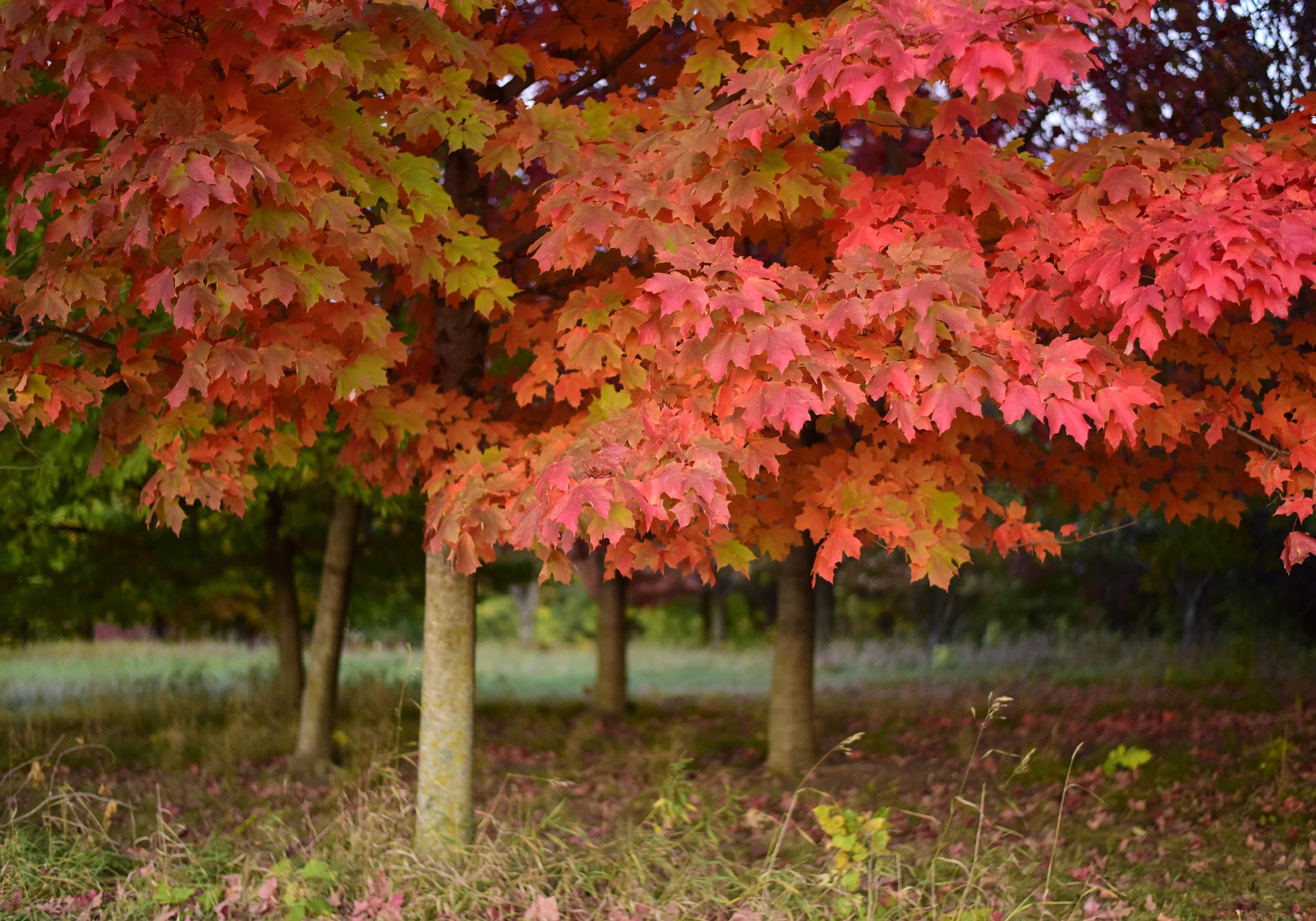
OCTOBER/NOVEMBER 2023, VOL. 42, NO. 5
grown this year on pages 8-9, and stop by the AppleHouse — just 1.5 miles west of the Arboretum’s main entrance — to pick up a bag of apples and a new variety of squash! Admission to the AppleHouse is free, and members receive a 10% discount.
Fall is a busy time at the Arboretum, and we have so many great events planned for our members and visitors. The Fall Color Trail Run/Hike takes place Oct. 6-8, and provides the perfect opportunity to check out the autumn leaves and maybe even discover a new favorite trail or walking path. As the colors fade and the snow begins to fall, Winter Lights will illuminate the landscape, creating an amazing spectacle that spills out across the grounds. I’m looking forward to bundling up and bringing my own family out to see the displays, which open Nov. 16.
I’m thankful for the community that makes all of this possible, and especially for the support of our visitors, members and donors, who contribute to the beauty of the gardens and grounds, as well as the education, research and conservation that set us apart.
I hope to see you on the trails soon!
Minnesota Landscape Arboretum Magazine is published six times a year by the Minnesota Landscape Arboretum. The Arboretum is part of the College of Food, Agricultural and Natural Resource Sciences (CFANS) at the University of Minnesota. The magazine is a benefit of Arboretum membership. To request a copy of this publication in an alternate format, please call 612-301-1257.
© 2023 Regents of the University of Minnesota. All rights reserved. The University of Minnesota is an equal opportunity educator and employer.
Elise Bremer, Editor
Brenda Drake Lesch, Art Director
Andrew Gapinski, Executive Director
Timothy S. Kenny, Director of Education

Susan Taylor, Ph.D., Director of Advancement
Matthew Clark, Ph.D., Director of Research
Tom Lany, Marketing, Communications & PR Manager
Glenn Stolar, President, Arboretum Foundation arb.umn.edu 612-624-2200 arbinfo@umn.edu
| ARBORETUM MAGAZINE // OCTOBER • NOVEMBER 2023 2
Cover photo by: Roger Smallbeck
Photo by Nick Kreevich
NICK KREEVICH • CURATORIAL MANAGER
In autumn, vibrantly colored oaks in red, orange and gold hues illuminate the landscape at the Arboretum. Minnesota is home to seven species of native oaks, but that’s just a drop in the bucket compared to the worldwide distribution of the genus, Quercus, which includes more than 430 species. There is one unique species of oak thriving at the Arboretum that has not only defied its designated USDA zone hardiness, but continuously puts on a late autumn show with its golden foliage, long after other trees have dropped their leaves.
Meet the English oak, a robust species of oak also known by its Latin name, Quercus robur, which is native to most of Europe and parts of far Western Asia. No, it’s not a native oak, but I’ll just let the photo do it justice. Despite this species originating on the other side of the pond, it still provides wildly beneficial resources to our own native fauna, including abundant acorn crops.
We have four specimens here at the Arboretum, two of which were received as seed in the late 1950s. Given to the Arboretum by a private individual, the pictured English oak is one of those original 1959 acquisitions. Those seeds and their genetics have stood the test of time,

surviving several decades of harsh Minnesota winters and proving that the English oak does have the ability to thrive in Zone 4b. It’s amazing to see just how large a tree can grow in a short 64 years, making it practically a teenager, as this species of oak can live for more than 500 years.
Oaks, along with maples and ginkgos, are some of the most prized trees when it comes to fall color. What makes the English oak unique is not only the consistent wash of gold, but also the late timing of color change. When all the other trees have senesced — or dropped — their leaves at the end of autumn, the English oak looks like a golden beacon in a sea of bare branches. It is the definition of a standout specimen tree for the managed landscape.
To get a close up view of the photographed English oak, be sure to stop by our Oak and Nut Collection, offering its peak fall color typically around the end of October.

ARBORETUM MAGAZINE // OCTOBER • NOVEMBER 2023 | 3
SEASONAL COLOR
Photo by Nick Kreevich
Acquired as a seed in 1959, the pictured English oak has stood the test of time, growing with the Arboretum throughout the decades. The original documentation, top right, marks the tree’s growth through its first few years.
NATURE FOCUS
MATT SCHUTH • NATURALIST
On cool, windless nights in early autumn, when the sliver of a new moon is outshone in the ebony sky by Orion the Hunter, Jack Frost waits patiently here on Earth to create his intricate ice crystal designs on our window panes. In spite of this imminent threat of freezing temperatures, bottle gentian continues to display its generous blue flower. Unlike its showier cousin, fringed gentian, bottle gentian never opens its petals. The naturalist John Burroughs called it “the nun among our wild flowers, a form closely veiled and cloaked.”
Because of those tightly closed petals, only large pollinators like bumble bees can enter the flower, thus keeping out the rain and nectar-robbing smaller insects. Bumble bees completely disappear inside the bloom, as if performing miniature
Houdini disappearing acts.
The bumble bee that successfully completes the difficult task of entering the flower is rewarded with one of the sweetest (40% sugar) and highest quantity of nectar of any flower. The tip of the flower’s corolla — or group of petals — is white, but after a bee has entered the flower and pollinated it, the tip of the corolla turns purple, signifying to other bees that the nectar is gone. Botanists call these marks honey guides, indicating to pollinators where nectar is produced in the flower.
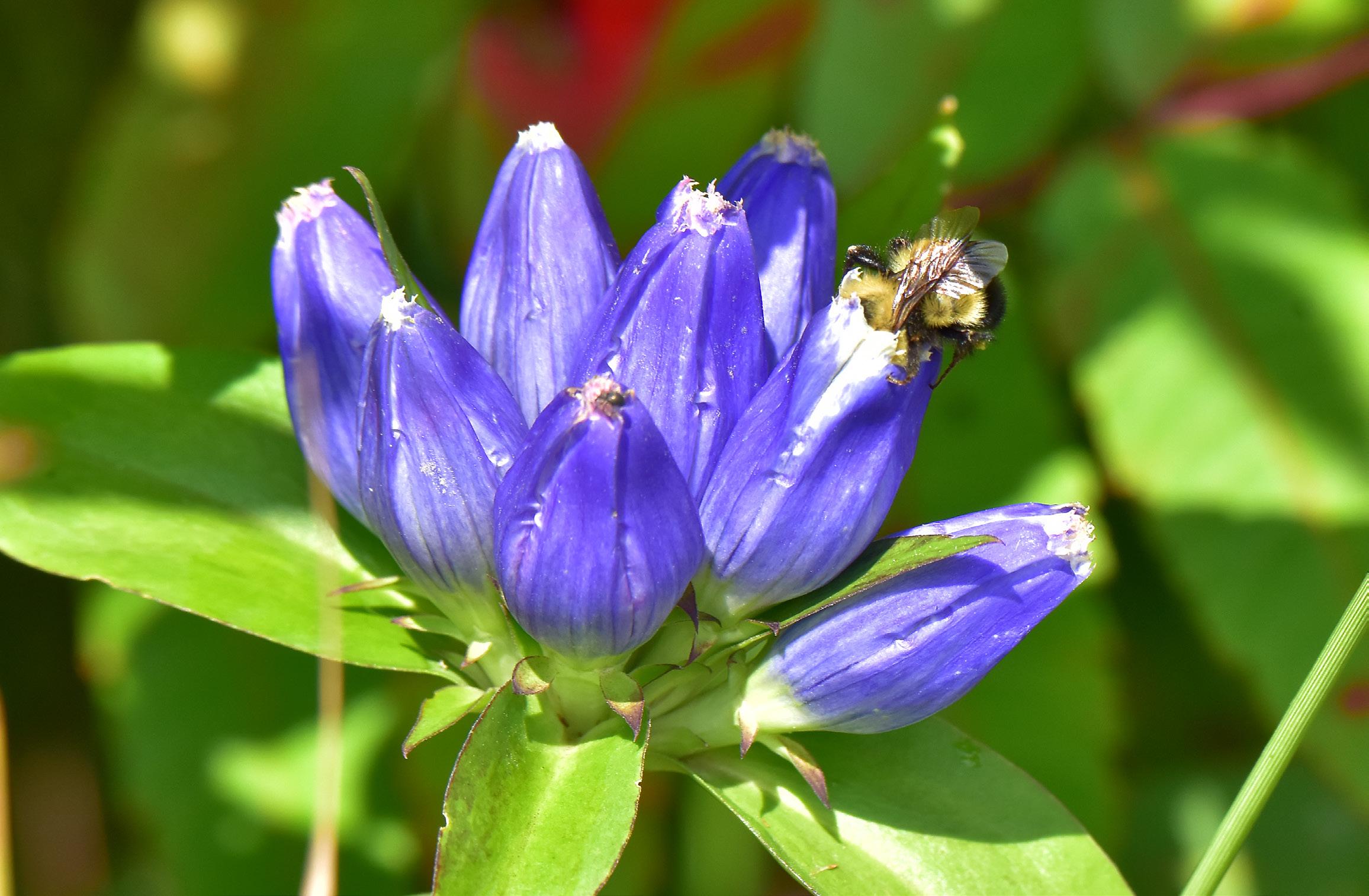
Gentian is named after King Gentius of Illyria, who supposedly discovered that the plant could cure a strange illness that was afflicting his troops. King Ladislaw of Hungary prayed for a cure from the plague. To seek a solution, he shot an arrow
into the air and hit a gentian plant. Charlemagne did the same and hit a thistle.
Gentian was traditionally used to treat stomach problems and ulcers, while the leaves acted as a refrigerant to lower high body heat. And it’s still used in food production today. Moxie, the rootbeer-like soft drink, contains gentian extract, and is considered an energy booster. Angostura bitters, a popular cocktail ingredient, also contains gentian.
Henry David Thoreau said, “The color of the gentian surpasses the color of a bluebird’s back,” and William Cullen Bryant called it “heaven's own blue.” However it is described, gentian provides wonderful color in our lives until the nipping winds of November arrive. Look for it in the Rock Garden at the Arboretum this fall.
| ARBORETUM MAGAZINE // OCTOBER • NOVEMBER 2023 4
Bottle gentian blooms late in the growing season, providing an excellent fall food source for foraging bumble bees.
Photo by Nature by Travis Bonovsky
MATT CLARK • ASSOCIATE PROFESSOR AND DIRECTOR OF RESEARCH, HORTICULTURAL RESEARCH CENTER
Cold hardiness remains a key issue when breeding new plant varieties for Minnesota. Our typical winters are anything but typical these days — especially with climate change impacting weather patterns, temperatures (both warm and cold) and precipitation.
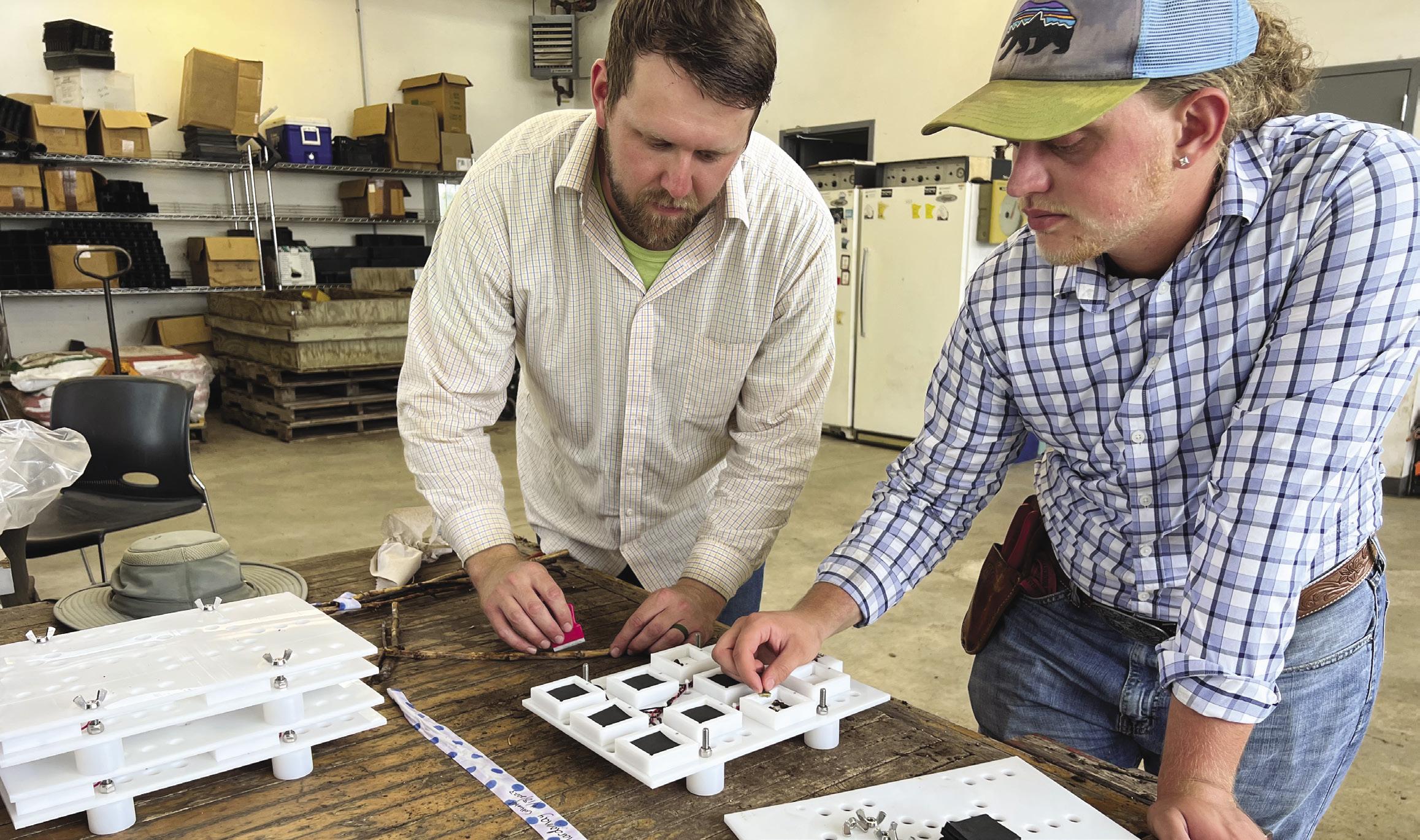
Historically, the Horticultural Research Center (HRC) served as a good site for test winters that regularly exposed plants to 30 degrees below zero, the benchmark for USDA Hardiness Zone 4. However, the frequency of such cold events has diminished over the past several decades. Scientists’ current understanding of how plants sense and respond to temperature across the winter has also changed. Advanced technologies aim to assist researchers in quantifying cold hardiness and learning more about the complex genetics
that regulate it.
Programmable freezers, such as the new Tenney Environmental Chamber at the HRC, allow scientists to precisely control the temperatures that plant samples experience over the course of hours or days. For example, grape buds can be exposed to declining temperatures from 32 degrees Fahrenheit to 40 below zero over 12 hours while simultaneously monitoring, in real time, when the buds freeze.
Specialized equipment running BudFreezer software can detect a small burst of energy when each bud freezes, the data is recorded, and then the researchers can accurately determine the hardiness for that plant on that date. When evaluated across the winter, a statistical model can be used to describe each plant’s performance through dormancy.
One paradigm change in cold hardiness
research is that it's not just the low temperatures in the middle of winter that impact a plant’s ability to survive. Dormancy, which keeps the plant from growing in the winter, reverses course as the weather warms and plants lose their cold hardiness throughout the advancing spring. Plants respond to a warm winter day and may start to grow or lose their cold hardiness. Not only that, an early spring frost can cause extraordinary damage to plants that break dormancy too soon.
The new freezer is especially useful for screening cuttings, buds and even potted plants such as those being screened by the University's woody landscape plant and turfgrass breeding programs. The equipment was purchased with funds from J. Frank Schmidt Family Charitable Foundation as well as the Minnesota Nursery Research Corporation.
ARBORETUM MAGAZINE // OCTOBER • NOVEMBER 2023 | 5
RESEARCH
Researchers Colin Zumwalde (left) and Doug Vines (right) prepare grapevine bud samples for cold hardiness evaluation in the freezing chamber.
Photo by Matt Clark
JEFF ISEMINGER • CONTRIBUTING WRITER
“When you support the Arboretum, you’re doing something for yourself, and you’re doing something for the community. It’s a twofer, and that’s rare.”
That strong affirmation comes from Richard Spiegel, a longtime supporter of the Arboretum. Seconding the motion is his wife, Judy Spiegel: “You can grow with the Arboretum, going there as a child through old age. It offers something for all ages and interests.”

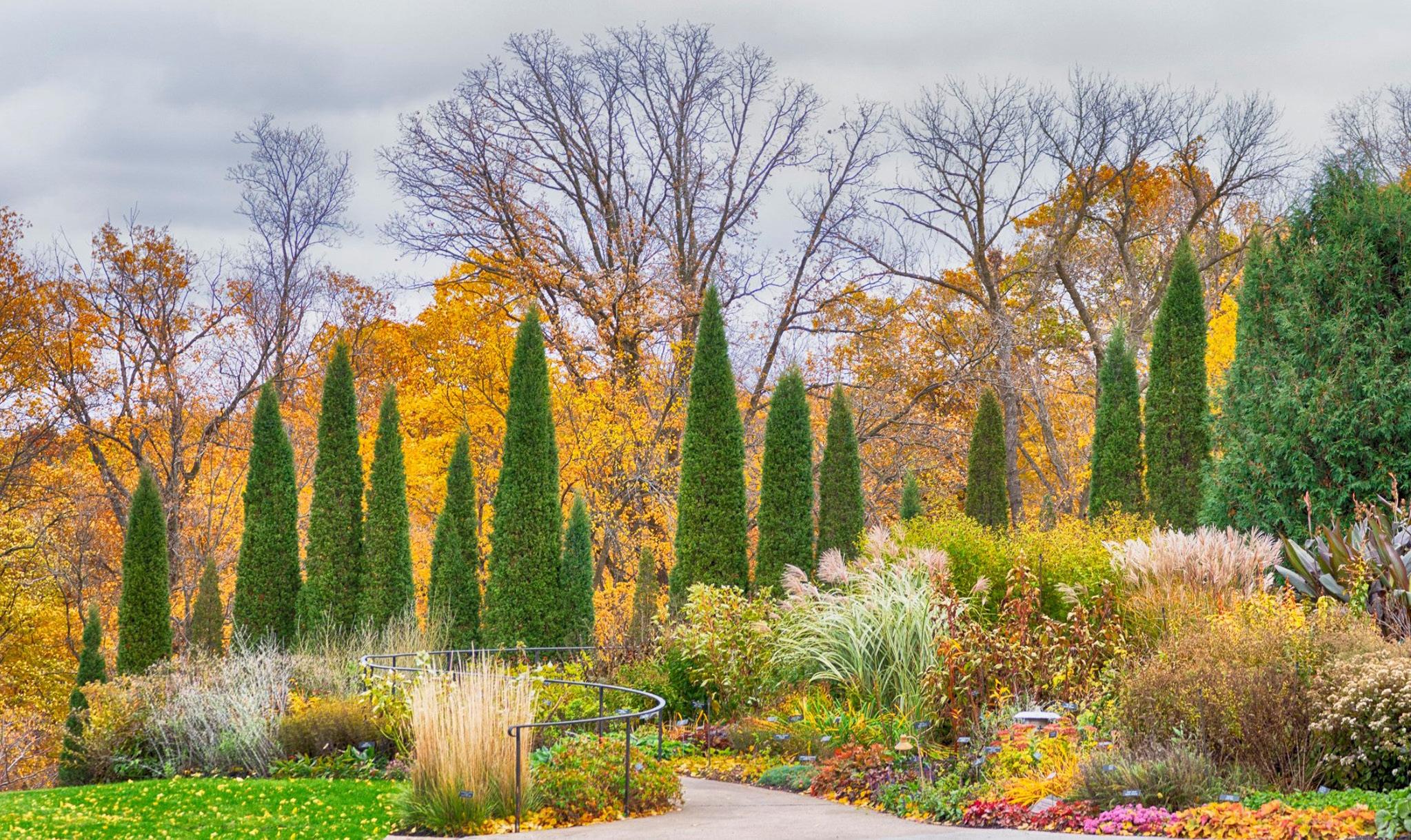
The Spiegels speak from experience. Richard served on the Board of Trustees for nine years, two as president, and he now is active as a Trustee Emeritus. He also has been a volunteer gardener, “a labor of love,” he said. One of the display gardens he’s tended on hands and knees is the Spiegel Entrance Garden in front of the Snyder Building. Richard and Judy endowed the garden in 2001 for “the education and benefit of future generations,” as the garden’s plaque states.
Arboretum Horticulturist Duane Otto created the original design of the garden in 1995 to coincide with the national symposium of the Perennial Plant Association, which was held in the Twin Cities that year. As the garden evolved over the years, the Spiegels decided to put their full support behind the garden to sustain it with help from Otto, staff and volunteers.
Judy has volunteered at the Andersen Horticultural Library for decades and served as president of the Friends of the Library. As a watercolorist, she and her teacher, Suzanne Galloway, started a project in 2015 called Flora and Fauna Illustrata, with the modest goal of portraying, as Judy put it,
“everything that grows at the Arboretum.” So far they, and many other artists, have produced more than 100 illustrations kept in the library’s rare books collection and shown each year in the Skyway Gallery, including the exhibit up now through March 1.
Judy works at the library’s annual book sale, which she said gives her the pleasure of “watching grandparents bringing grandkids to get them excited about reading.” Like Judy, Richard savors the singular joy that flows across the spectrum of human life. “It’s beautiful to see different generations delighting in the Arboretum,” he said, “and to see what the Arboretum does to enrich the lives of visitors.”
The Spiegels have mimicked some of the Arboretum’s beauty beyond its borders. Observing the huge variety of plants at the Arboretum “has enabled us to develop a perennial garden at our home,” Richard said. They’ve also broadened their botanical knowledge by visiting gardens in England, Wales, Scotland and Ireland.
But the Spiegels still consider the Arboretum a horticultural and emotional lodestone — for them and for others: “The Arboretum offers the beautiful opportunity for people to be in touch with nature, which then becomes part of them,” Richard said.
| ARBORETUM MAGAZINE // OCTOBER • NOVEMBER 2023 6 THE JOY OF GIVING
The Spiegel Entrance Garden welcomes visitors to the Snyder Building, putting on a show throughout the seasons.
Photos by (bottom) Norbert Lucas; (top) Jennifer Peterson
Richard and Judy Spiegel
Spending time in nature benefits our health, and studies show that even viewing nature photographs can reduce levels of anxiety and stress. Each year, members and visitors of the Arboretum are inspired to deepen connections with the natural world by participating in a wide variety of photography classes and events.
In fact, the Arboretum has one of the most comprehensive adult education nature photography programs in the nation, and this autumn, it's embarking on a new program not available at any other public garden.
As days shorten and grow colder, why not cozy up indoors and spend your evenings with the Art of Photography Speaker Series? This online series features exceptional photographers working with landscape, nature and our environment. Once

a month, from October through February, a featured photographer will present their work while sharing their process, inspiration and more. Each event wraps up with a moderated period of questions and answers, so curiosity is encouraged!
The Arboretum is thrilled to open the series with Mitch Dobrowner, an award-winning photographer whose stunning black and white images of desert landscapes and violent storms have placed him among America’s top landscape photographers. Encouraged by his family and inspired by the work of Ansel Adams, Dobrowner returned to his passion of photography after years of running a business and raising a family.

With an eye for the sculptural presence of nature, patience and a modified digital camera, his work has reinvigorated popular fascination with black and white landscape photography.
February thaws with the vibrant work of Cynthia Dickinson, an award-winning local photographer with an international reputation. Whether working out of her Edina studio, the Arboretum’s gardens or along the St. Croix river, her artistry transforms nature into an experience entirely its own. Her process of layering floral photographs reflects our complex relationship with the natural world and conflicted feelings about our changing environment while remaining utterly beautiful.
Each speaker brings a unique background and area of expertise to this series, with something for photographers and nature lovers alike to learn from and connect to. Learn more about the other speakers in this series at z.umn.edu/art-ofphotography and save by registering for the whole five-part series.
ARBORETUM MAGAZINE // OCTOBER • NOVEMBER 2023 | 7 LEARN & DO
FRANK MEUSCHKE • ADULT EDUCATION SPECIALIST
t
“Rope Ou
” by Mitch Dobrowner
Photographer Mitch Dobrowner (left) is October’s featured speaker, exploring North America’s expansive landscapes through black and white photography.
In the fall, Arboretum staff and volunteers harvest, label and transport the hundreds of varieties of cucurbits to the AppleHouse and Arboretum.
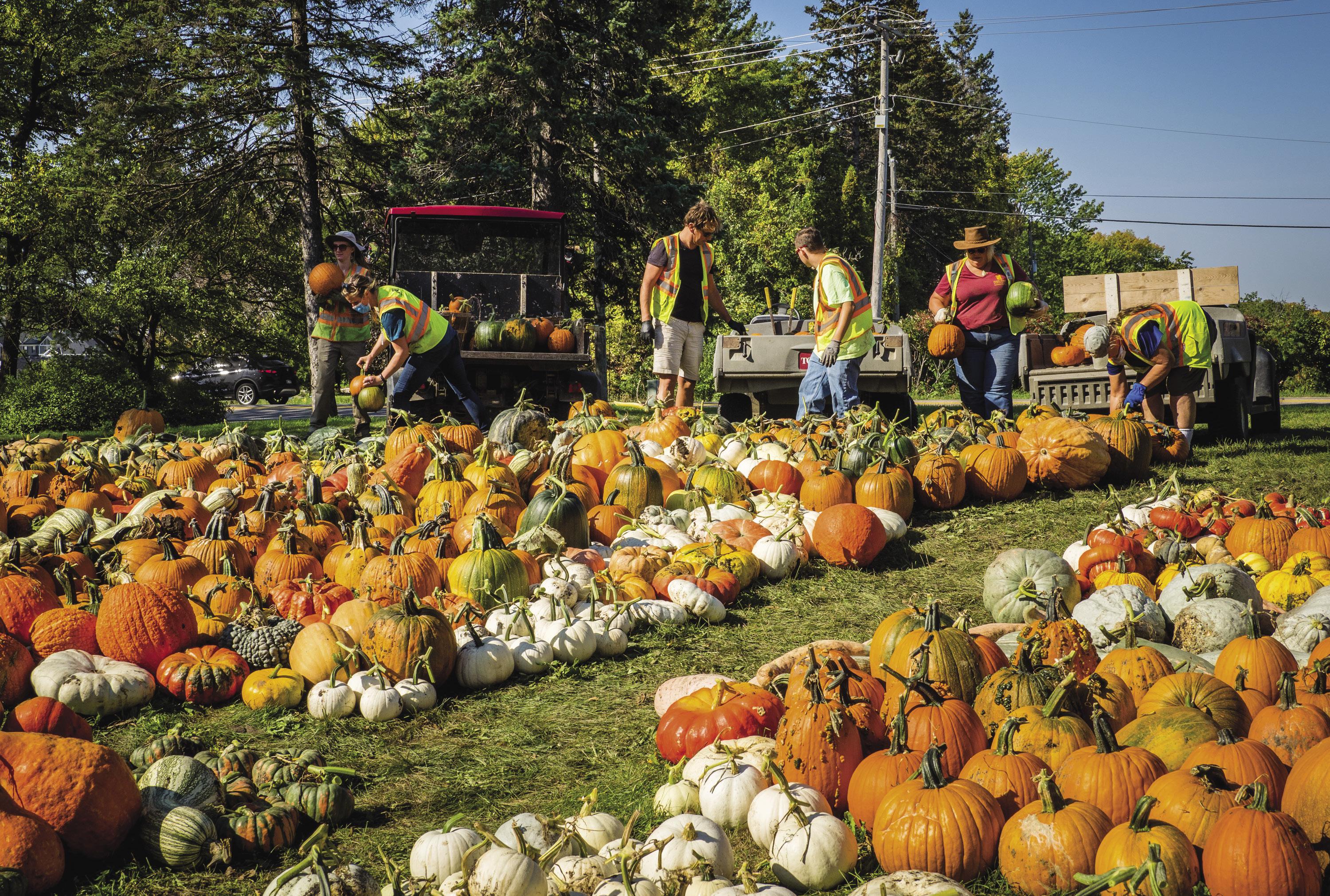
While the Horticultural Research Center (HRC) at the Arboretum is known for producing a wide range of cold-hardy grapes suitable for our climate, there’s another vine crop that takes up residence in the fields surrounding the rows of grapevines in the summer months. In fields that are too low — or wet — for grape growing, tendrils of pumpkin, squash and gourd vines snake across the ground, creating a lush mat of green foliage, bright yellow-orange flowers and eventually — fruit!
The fanciful fruits of these pumpkins, squash and gourds (collectively known as cucurbits or Cucurbita) are selected, nurtured and harvested by the HRC’s John and Jenny Thull. Viticulturists by day, John and Jenny manage the vineyards for the HRC’s cold-hardy grape research, so it wasn’t too much of a stretch to expand their interest in vines to include some wonderfully whimsical pumpkins. John and Jenny — who met at the HRC in 2006 and have been married 11 years — have expanded their cucurbit
operation over the years to include 4.5 acres across 14 individual fields planted with more than 350 varieties of pumpkins, squash and gourds!
The truck loads of multi-hued cucurbits in every shape and size are harvested in the fall by Arboretum staff and volunteers to lend autumn flair to the Dahlberg Terrace and surrounding gardens. Visitors can also shop at the AppleHouse — located 1.5 miles west of the Arboretum’s main entrance — for exceptional varieties of cucurbits hand-selected by Jenny. This year’s offerings will include more than 40 varieties of squash and 160 varieties of ornamental pumpkins, including a wide selection of orange pumpkins — a harvest-season classic.
Starting as early as December, Jenny pores over seed catalogs, selecting and ordering the seeds that will be planted in the spring. This process takes 12-15 hours, and can be quite competitive! Trendy and time-honored varieties are quick to sell out, and Jenny has to shop early to get ahead of
| ARBORETUM MAGAZINE // OCTOBER • NOVEMBER 2023 8 HARVEST
ELISE BREMER • EDITOR
The inside scoop on the pumpkin, squash and gourd varieties you never knew you needed
Photo by Sara Pace
the competition. While white pumpkins are still a fall favorite, yellow pumpkins — with fun names such as Mellow Yellow — are the latest craze. Jenny orders from a variety of seed companies, and prefers to shop smaller businesses, which often have the most unique offerings.
In addition to her talent growing vines, Jenny is also a trained chef with extensive experience in the restaurant industry. This passion for cooking and exploring new flavors is what drives Jenny to educate consumers about underrepresented squash varieties that far outperform the usual suspects found in supermarkets. Some of her favorites for cooking include a butternut squash variety called Rogosa Violina Gioia, named for its violin shape and prized for its superior flavor, as well as the charmingly named Sea Pumpkin, or Marina di Chioggia, which features a blueish color and very dry flesh, making it perfect for gnocchi or ravioli.
If the promise of Cinderella-inspired pumpkins complete with creeping vines and curlicue tendrils has inspired you to grow your own pumpkin patch, the Thulls recommend cucurbits as a good beginner crop. And for
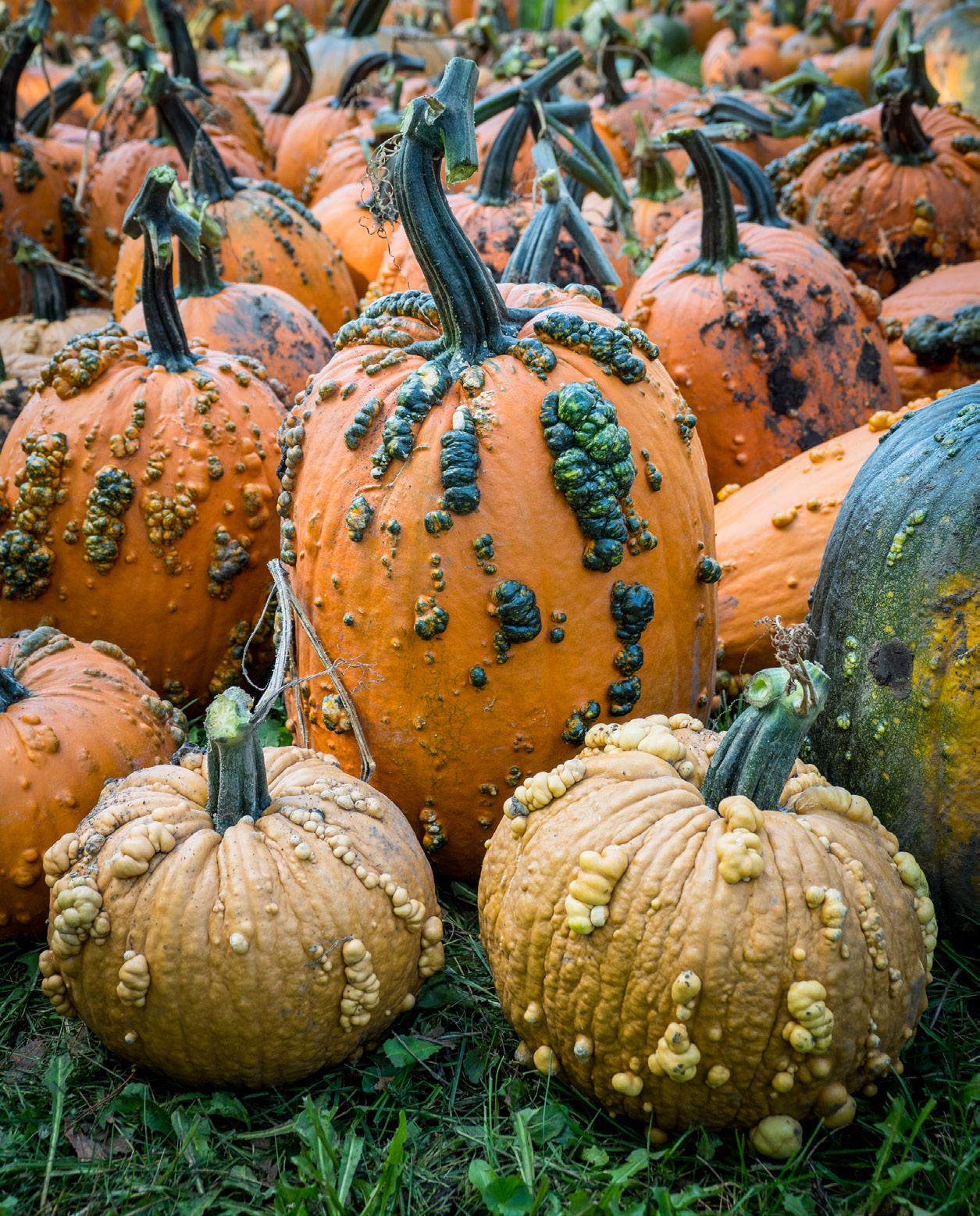
those whose garden space is limited to a porch or patio, growing pumpkins, squash and gourds is not out of the question! There are many bush or semi-bush varieties on the market, including petite versions of honeynut, buttercup and acorn squash and even some bush-type pumpkins. These plants stick to a downsized footprint and typically produce smaller fruit, making them an excellent choice for containers or raised beds.
Once you’ve selected your perfect pumpkin and carved it with your design of choice, it seems inevitable that squirrels will slowly gnaw away at the lovingly rendered details of your Jack o’lantern. Don’t worry, Jenny has a solution for this, too! She recommends rubbing vaseline (or cooking spray) across the face of your pumpkin, which seals the cut edges keeping the fragrance of the cut flesh from attracting squirrels. If that doesn’t do it, Jenny recommends sprinkling cayenne pepper in a protective ring around your pumpkins, “squirrels just hate it!”
Don’t miss the pumpkin displays and pumpkin tree designed by the Thulls on display on the Dahlberg Terrace throughout October, and be sure to stop into the AppleHouse for pumpkins, squash and gourds, and of course, apples!

Jenny Thull’s Speckled Hound Pumpkin Pie Recipe
Speckled Hound squash, which has the perfect moisture and sugar levels for baking, is one of Jenny Thull’s favorites. For Jenny’s thoughtfully developed pie recipe, as well as other delicious squash recipes, head to the Nature Notes blog at z.umn.edu/pumpkin-recipes.
ARBORETUM MAGAZINE // OCTOBER • NOVEMBER 2023 | 9 HARVEST
The lumps, bumps and “warts” found on some cucurbit varieties are typically a sign of high sugar content.
Every year, John and Jenny Thull decorate the KARE 11 backyard studio set with Arboretum-grown pumpkins, squash and gourds.
Photo by Sarah Jackson
Photo by Sara Pace
SCARECROWS

IN THE GARDEN
Through Oct. 31
Scarecrows in the Garden adds a festive note to the Arboretum’s autumn displays on the Dahlberg Terrace and Scarecrow Hill. Check out the artistry of the experts from Bachman’s, Arboretum staff and members of the community. Learn more at arb.umn. edu/events/gardenscarecrows
PUMPKIN DISPLAYS
Oct. 1-31
Pumpkins, squash and gourds in every color, shape and size add fall flair to the Dahlberg Terrace and surrounding gardens as well as the Scarecrows in the Garden display. After you’ve marveled at the many unique varieties on display, visit the Arboretum's AppleHouse (about 1.5 miles west of the Arboretum’s main entrance) to buy Arboretum-grown pumpkins, squash and gourds for your seasonal displays or autumn meals. Learn more at arb.umn. edu/events/pumpkindisplays.
DAKOTA SACRED HOOP WALK
Ongoing
Twin Cities Digital Artist Marlena Myles, a member of the Spirit Lake Dakota tribe, presents an augmented reality art exhibition at the Arboretum, which begins in the Harrison Sculpture Garden and passes through five stops across the grounds. A smartphone and the Revelo AR app are required. Learn more at arb.umn.edu/sacredhoopwalk

AUXILIARY HARVEST SALE
Oct. 6-7, 9 a.m.-4 p.m and Oct. 8, 11 a.m.-3 p.m. Shop from a range of home décor, potpourri, Arboretum wood creations, knitwear for adults and children, beautiful autumnal wreaths and arrangements, cards, toys and many other creative arts made by Auxiliary members. All proceeds benefit the Arboretum. Learn more at arb.umn.edu/auxiliary.


FALL COLOR TRAIL RUN
Oct. 6-8, 8 a.m.-3:30 p.m. Enjoy beautiful fall colors on the Arboretum’s trails this autumn! Pick your course (1K, 5K or 10K), start time and date (Oct. 6-8) and experience the changing season at the Arboretum. New this year, racers can compete in a timed competition Saturday morning with a 10K start at 8 a.m. and 5K start at 9:30 a.m. This event is staggered over three days to prevent overcrowding of the trail space and maximize enjoyment for all participants. Routes will go along Wood Duck Trail, Prairie Trails and the Dog Commons, so runners and hikers can enjoy the trail run/hike at their convenience. Learn more at arb.umn.edu/falltrailrun

| ARBORETUM MAGAZINE // OCTOBER • NOVEMBER 2023 10 EVENTS
Photo by Mark MacLennan
Photo by Marlena Myles
Photo by Linda Orwoll
Photo by Mark MacLennan
MINNESOTA HERB SOCIETY FALL SALE
Oct. 6-7, 9-4 p.m.
Shop for gifts, kitchen and personal-care items and culinary delights with an herbal theme while supporting the Minnesota Herb Society and its work in the Arboretum’s herb gardens. Learn more at arb.umn.edu/ events/herbsocietyfallsale

BOOK SALE
Oct. 6-8, 10 a.m.-4 p.m.
Shop for used books, CDs and DVDs on a wide variety of subjects. Thanks to the support of the Arboretum community, this event, by the Friends of the Andersen Horticultural Library, typically raises between $10,000-$12,000 in support of the library. Learn more at arb.umn. edu/events/librarybooksale
WINTER LIGHTS
Opening Night Nov. 16, 6:30 p.m.
YOGA IN THE GARDENS
Complete your visit to the Arboretum this fall with a restorative yoga session! Registration is $5 per class for members and $20 for non-members and includes daily general admission. Get tickets (required) at arb.umn.edu/yoga
Oct. 8, 10 a.m. — Yin & Sound Bath in the Sculpture Garden
Oct. 19, 6 p.m. — Vitality Vinyasa Flow in the Sensory Garden
Oct. 22, 10 a.m. — T'ai Chi Chih in the Chinese Garden
Nov. 5, 10 a.m. — Slow Flow in the Snyder Auditorium
Nov. 19, 10 a.m. — Vinyasa Yoga in MacMillan Auditorium

FULL HUNTER’S MOON HIKE
Oct. 28, 6:30-9:30 p.m.
Enjoy an evening at the Arboretum under the glow of the full October moon with a self-guided hike along Three-Mile Walk illuminated with tealights. Along the way, stop at the Harrison Sculpture Garden to experience a sweeping, panoramic view of the night sky from the highest point in the Arboretum. Programming at the Sculpture Garden will include:

• Telescopes sighted on noteworthy celestial objects as well as astronomy knowledge provided by the MN Astronomical Society;
• Evening access to the Dakota Sacred Hoop Walk;
• A full moon intention-setting activity.
Be among the first to experience the magic of Winter Lights with a lighting ceremony at 6:30 p.m. Nov. 16 in the Oswald Visitor Center with a countdown to light up the Great Hall. Enjoy winter-themed decor indoors and outdoors, cookies and hot cocoa and festive music. Guests are free to explore the outdoor self-guided walking tour of lights at their own pace throughout the event.
In addition to many Winter Lights nights in November and December, save the date for special Winter Lights events, including the Date Nights Nov. 30 & Dec. 14, Family Nights Dec. 7 & 21, December Gift Market Dec. 9-10 and a New Year’s Eve Celebration Dec. 31.
Tickets are required for Winter Lights viewing nights and special events for all visitors including members of all levels. Members can reserve tickets starting Oct. 2 while non-members can reserve tickets starting Oct. 11. Register at arb.umn.edu/winterlights

ARBORETUM MAGAZINE // OCTOBER • NOVEMBER 2023 | 11 EVENTS
Photo by Todd Mulvihill
Photo by Liz Potasek
Photo by Jason Boudreau-Landis
WINTER LIGHTS MUSIC
SERIES
Nov. 17-Dec. 23
Warm up in the Oswald Visitor Center and enjoy the sounds of the season on Fridays, Saturdays and Sundays! To view the full list of performances, head to arb.umn.edu/events/ winterlightsmusicseries

APPLEHOUSE AND HOLIDAY BOUTIQUE
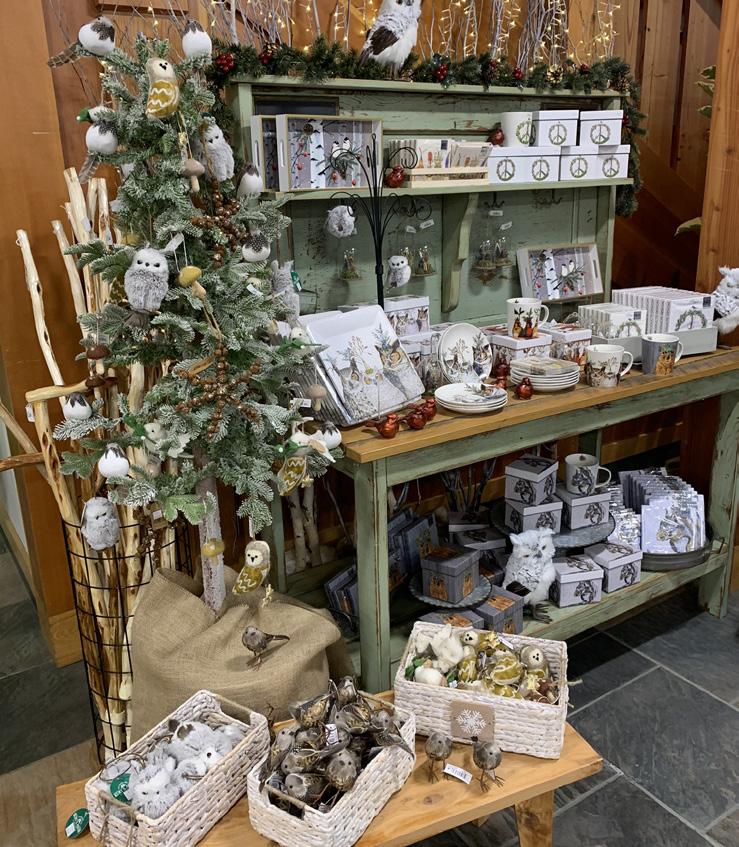

Nov. 6-Dec. 20
The Arboretum’s popular AppleHouse — located at 7485 Rolling Acres Road — becomes a Holiday Boutique in November and December. Find everything you need to make the holidays special, including seasonal decor, gifts and gourmet goodies for your holiday meals. Apples and Arboretum-grown pumpkins, squash and gourds will also be available while supplies last. Arboretum members receive a 10% discount with their membership card on AppleHouse purchases. During Double Discount Days (Nov. 8-22), members will receive a 20% discount for showing their membership card at the register. Learn more at arb.umn.edu/apple-house
GARDEN TRAVEL TOURS KINGDOM OF MONARCHS

Feb. 15-24, 2024
The Arboretum, in partnership with Knowmad Adventures, is proud to announce an incredible Mexico travel experience with Arboretum host, David Remucal, Ph.D, the Delores E. Isaacson Curator of Endangered Plants. This 10-day trip — A Journey Through Mexico’s Monarch Migration, The Art + Culture Of Oaxaca & Mexico City’s Gardens — immerses travelers in millions of monarch butterflies as well as vibrant indigenous cultures in the villages of Oaxaca, breathtaking pre-Columbian ruins and world-renowned Mexican cuisine. Travelers will also explore spectacular gardens, parks and an ancient agricultural heritage system with floating Aztec gardens. Join the Arboretum and excellent local naturalist guides on this once-in-a-lifetime adventure. For more information visit arbtravel.umn.edu
AUXILIARY HOLIDAY SALE
Dec. 1-2, 9 a.m.-4 p.m. and Dec. 3, 11 a.m.-3 p.m.
Save the date for the annual Auxiliary Holiday Sale offering exquisite handcrafted winter and holiday seasonal gift items. Shop knit scarves and hats for the entire family, felted and quilted items, home décor, spa gifts, jewelry, children’s toys, cards and gift tags, seasonal wreaths and arrangements plus unique and beautiful wood items created for the home. This is a can’t-miss sale for gift items for everyone! Learn more at arb.umn.edu/auxiliary
DOUBLE DISCOUNT DAYS
Nov. 8-22
Arb members always receive a 10% discount on Gift & Garden Store purchases, but from Nov. 8-22, members take an additional 10% off purchases at the Gift & Garden Store and AppleHouse and Holiday Boutique for a total discount of 20%. Learn more at arb.umn.edu/events/ doublediscount.
| ARBORETUM MAGAZINE // OCTOBER • NOVEMBER 2023 12
EVENTS
Photo by Johanna DeBuhr
Photo by Jason Boudreau-Landis
Photo by Sarah Bednarek
The Arboretum is a wonderful place to learn, thanks to a variety of experts, scenery and plant collections. Prices listed are for members/non-members respectively. See a complete list of classes for adults, children and families at arb.umn.edu/learn. Follow the class links to register or call 612-301-1210.
Creative iPhone Photography: Shooting & Composition
Oct. 1, 10 a.m.-4 p.m.
This hands-on class for beginners includes classroom and outdoor practice time. Learn to make effective, meaningful and beautiful photographs with your iPhone or iPad. Discuss the 10 rules of composition, iPhone settings, the importance of identifying a main subject and deciding what to shoot. Cost is $105/$120.
A Wonder Filled Experience (AWE)
Oct. 10 or 19, 2-3:25 p.m.
Learn the science behind the healing power of nature during this immersive nature-based experience, part of the Arboretum’s Nature Heals Initiative. Understand and practice breathing and grounding exercises to help calm your mind and enhance your time in a natural environment. Cost is $20/$35.
PHOTOGRAPHING FALL COLOR
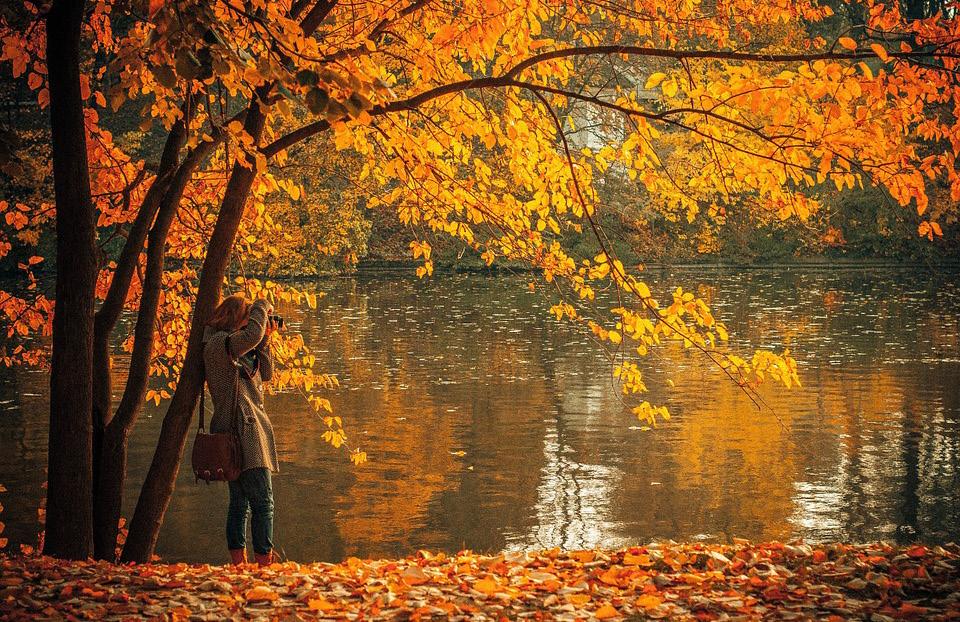
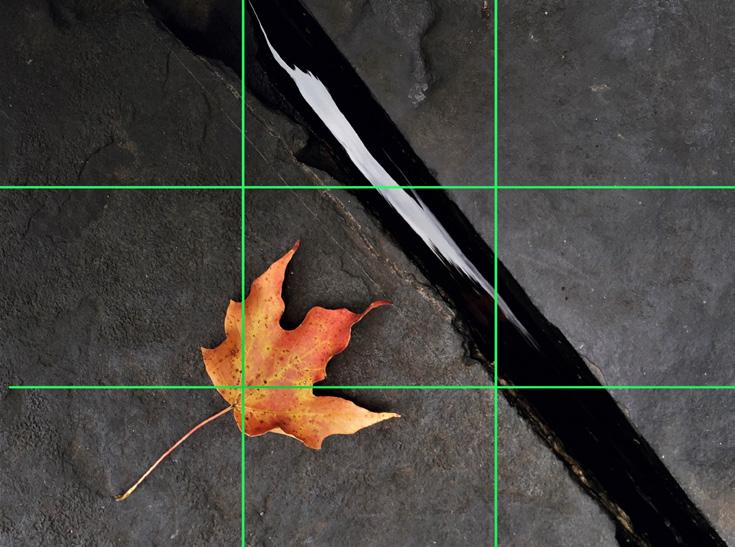
Oct. 8, 9 a.m.-1 p.m.
Art of Photography Speaker
Series: Mitch Dobrowner (Online)
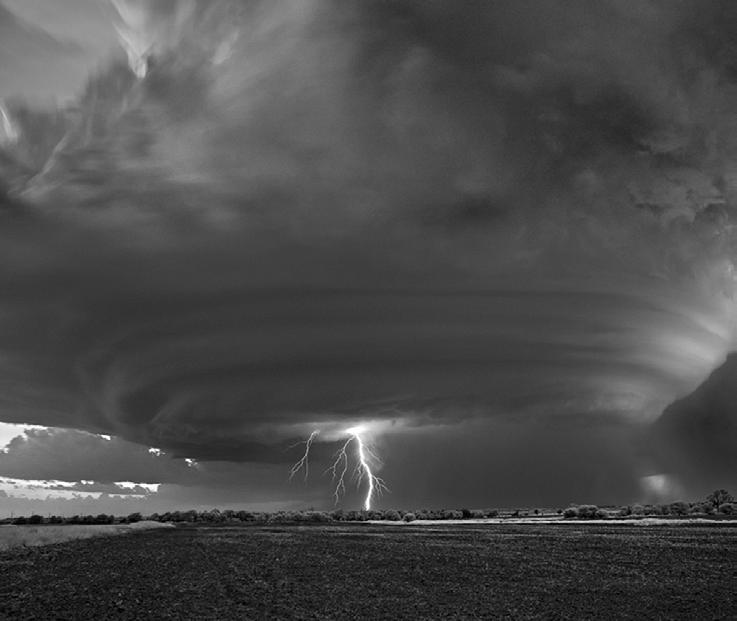
Oct. 10, 7-8:15 p.m.
Mitch has traveled throughout North America to photograph extraordinary geologies, vast urbanscapes and extreme weather. He creates black and white images inspired by the photography of masters such as Ansel Adams and Minor White. See story on page 7. Cost is $15/$20.
Painting in Watercolor: Crabapple Notecards

Oct. 13, 9:30 a.m.-4 p.m.
Complete four small-scale notecard-sized paintings as you practice new painting techniques from composition to paint handling and develop a deeper understanding of the watercolor process. Some watercolor experience is preferred. Cost is $99/$120.
Drawing in Graphite Pencil: Owl
Oct. 14, 9:30 a.m.-12:30 p.m. or 1:30-4:30 p.m. This beginner-to-intermediate-level drawing class
will teach you to develop an observation of shape, composition and perspective as you draft your own graphite drawing of an owl. Learn fundamental skills of drawing, including line weight, shading, layering and blending techniques. Cost is $79/$97.
Homeschool Day: It’s a Pumpkin’s Life (Grades 1-3)
Oct. 18, 12:15-2:15 p.m.
Celebrate the change in season with pumpkins! Learn about the three different pumpkin families and how to grow a giant pumpkin. Start your own pumpkin seed investigation and sort and taste fruits, vegetables and seeds just like a plant scientist. Cost is $15/$18 per student and one adult educator.
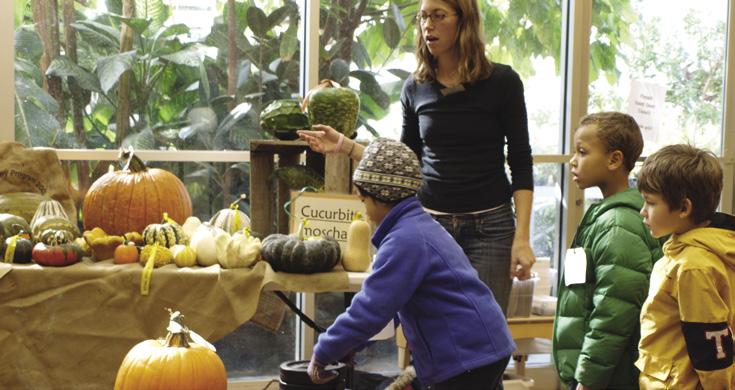
ARBORETUM MAGAZINE // OCTOBER • NOVEMBER 2023 | 13 LEARN
Photo by Eric Mueller
Photo by Mitch Dobrowner
Painting by Sonja Hutchinson
Photo by Vienna Volte
Photographers of all levels will learn to capture the fall colors by exploring proper camera settings, composition, landscape fundamentals and post processing to help you create amazing photos. Class includes a lecture and a photo hike across the Arboretum grounds where you can practice skills and concepts together. Cost is $92/$107.
Creative iPhone Photography: Understanding Light
Oct. 21, 9 a.m.-noon
Explore techniques for making better photographs on your iPhone, including how to recognize and use soft and hard lighting; the effects of color temperature on your images; and simple ways to modify available light and create a DIY light kit. Cost is $75/$90.
Painting in Watercolor: Autumn Landscapes
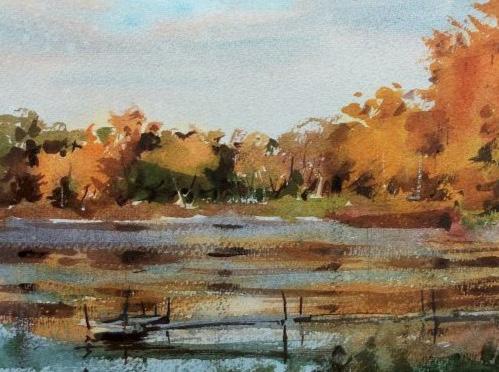
Fall Colors — Oct. 30, 9:30 a.m.-3:30 p.m.

Red Oaks — Nov. 20, 9:30 a.m.-3:30 p.m
Foliage is the star of this intermediate-level watercolor series. Practice watercolor painting techniques such as thirsty brush and dry brush to create texture. Understand where to start a painting and how to develop it in layers. Cost for each session is $99/$120; bring your own supplies.
PHOTO FIELD TRIP: THE GREAT SANDHILL CRANE MIGRATION

Online Webinar: Oct. 26, 6:30-8 p.m., In-Person Field Trip: Oct. 28, 7-11 a.m. Learn to successfully photograph sandhill cranes landing, standing and taking off in any weather and light condition. The online session will teach about migration patterns, behavior, how to photograph migratory birds in flight and in groups, how to isolate birds from backgrounds and strategies for working with challenging lighting. Then, meet in person at Crex Meadows in Grantsburg, Wisconsin, to practice together at the instructor’s favorite locations. Cost is $155/$160.
add vignettes, use filters and other tools. This beginner-level class is part presentation, part demonstration and part hands-on editing. Cost is $80/$85.
Art of Photography Speaker Series: Douglas Hill (Online)
Nov. 14, 7-8:15 p.m.
Hill's photography has focused on Los Angeles, a city made possible by the redirection of water from the mountains, thus converting desert land to a liveable human environment. He has explored the city’s architecture and infrastructure, the Los Angeles River and its tributaries, revealing a poetic relation of architecture, plant life, light and shadow. See story on page 7. Cost is $15/$20.
Beeswax Luminary:
Gifts From the Hive
Nov. 6, 1:30-3 p.m. or 5-6:30 p.m.
Bee Center Beekeeper Ping Honzay will guide you through the step-by-step process to create your own beeswax luminary, a unique gift or centerpiece for holiday gatherings. Embellish your work with natural materials such as pressed leaves and flower petals, if desired. All supplies are included. Cost is $32/$47.
iPhone Photo Editing Made Easy (Online)
Two-Session Series, Nov. 7 and 9, 6:30-9 p.m. Make your photos look their best by editing them to adjust contrast, structure, brightness, saturation and more. Learn to remove blemishes,
Painting in Acrylic: Sunflower

Nov. 10, 9:30 a.m.-12:30 p.m.
This introductory-level class explores shape, pattern, texture, composition, color mixing and basic painting techniques. Watch live demonstrations and experiment as you create your own composition on a 12”x16” canvas. All supplies are included. Cost is $79/$97.
Painting in Watercolor: Fanciful Forest
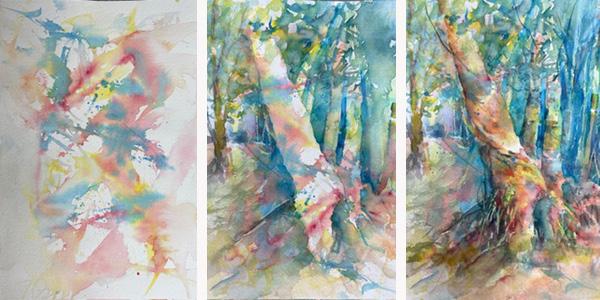
Nov. 17, 9:30 a.m.-12:30 p.m.
This all-levels class will help you to define trees in the foreground of your painting against an abstract background to render a bright forest in watercolors. Develop the layers in your forest as you practice lively brushwork and lifting techniques. Cost is $62/$79.
| ARBORETUM MAGAZINE // OCTOBER • NOVEMBER 2023 14
LEARN
Painting by Dan Mondloch
Photo by Don Tredinnick
Photo by Laura Cogswell
Painting by Aryn Lill
Painting by Sonja Hutchinson
JULIE PETERS • COMMUNICATIONS STRATEGIST
For Susan Cross, a love for the Arboretum began to blossom in the mid-1970s when then Director Dr. Leon Snyder offered Susan and her husband Leonard advice on the best trees to grow at their new home in Chaska — even sharing some seeds with them.
Cross doesn’t remember the type of tree and didn't have luck with the seeds, but a lifelong admiration for the Arboretum was planted.
“I’ve gotten so much inspiration here,” said Cross, now celebrating 50 years as a member. “What I have found most interesting is the growth, change and evolution. That has kept me as a member all these years.”
The former Air Force Reserve nurse, now 78, recalled that she and her husband — new to the area — were taking a drive in spring 1973 and stopped at the Arboretum’s Frog Hollow (once a machine shed and later an education center).
“There was still snow on the ground,” she said.
“We signed up for a family membership.”
Cross has always delighted in the Arboretum’s ever-changing landscapes and is especially fond of showy varieties such as magnolias and redbuds. “There’s something each week here that’s different,” she said.
She’s worn countless hats over the years — both as a longtime volunteer and as a part-time employee. She also serves as a Trustee Emeritus, is part of the Arboretum’s Operations Committee and volunteers as a Friend of the Andersen Horticultural Library.
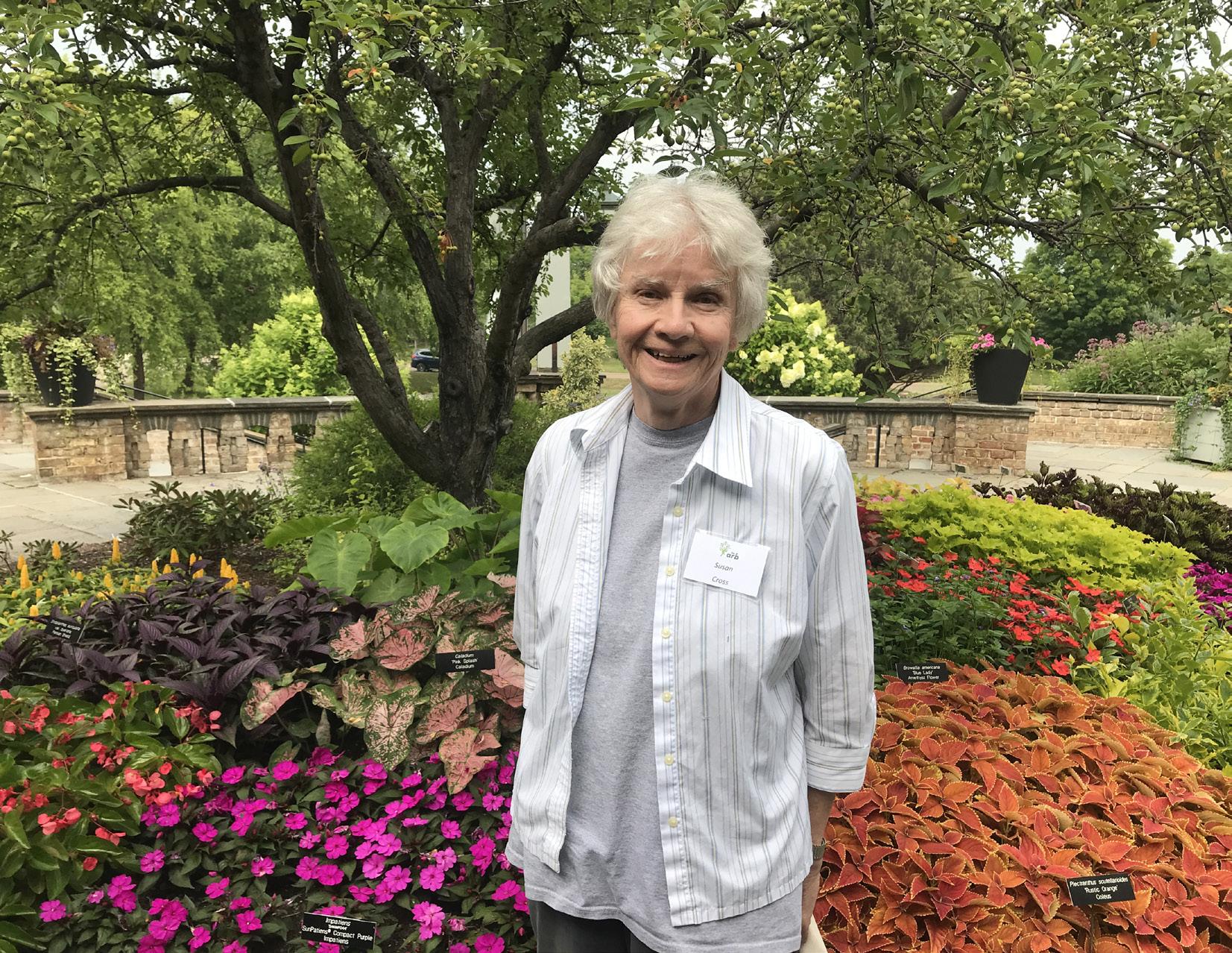
The Andersen Horticultural Library, where Cross has championed the oiling of the precious George Nakashima customdesigned wood furniture each year — on a day affectionately called “Miserable Day” — holds a special place in her heart. “I’ve done lots of different things here, but I’ve always gone back to the library,” she said.
Give the Gift of Nature With an Arboretum Gift Membership
Looking for the perfect gift to connect loved ones in your life to plants and the natural world? At the Minnesota Landscape Arboretum, access to the wonder of nature is available 363 days a year.

A gift of membership provides yearround access to the leading northern landscape arboretum, featuring more than 1,200 acres of gardens, natural areas and miles of hiking trails.
Membership to the Arboretum includes:
• Arboretum admission for an entire year;
• Year-round free events and activities;
• Special discounts to Arboretum classes;
• Early ticket access to signature events including Taste & Toast and Winter Lights;
• Reciprocal admission to public gardens throughout the U.S.;
• Subscription to Arboretum Magazine.
In addition to providing access to the Arboretum, memberships help maintain the stunning landscapes at the Arboretum and support plant research and local and global conservation efforts. Purchase a gift membership by calling 612-301-1257 or see arb.umn.edu/ support/membership
ARBORETUM MAGAZINE // OCTOBER • NOVEMBER 2023 | 15
Photo by Steve Silverman
MEMBERSHIP
Photo by Julie Peters
Susan Cross has been a member of the Arboretum since 1973.
Oswald Visitor Center
3675 Arboretum Drive
Chaska, Minnesota 55318-9613
Stay in the know!
Follow us on social media.
Art at the Arboretum
For more information on upcoming art exhibitions and events visit arb.umn.edu/art.
REEDY GALLERY
Children of Nature: Find Your Wonderland | Through Oct. 29 Artist Kristin Maija Peterson’s paintings explore the question of beauty in the natural world, asking: “What is considered beautiful, and what is not?” View the exhibition and meet the artist in the Reedy Gallery from 11 a.m.-2 p.m. on Oct. 7.
The Abstract Essence of Nature | Nov. 2-Jan. 21, 2024
Abstract art can take you to unexpected places! This exhibition's six featured artists — Andrea Canter, Dita Masters, Morgan Mercer, Sue Mooney, Paul Richards and Kathy Stratton — use a variety of mediums, styles and techniques to facilitate new discoveries at every turn, taking viewers on a remarkable artistic journey.
CAFE GALLERY
Rooted in Nature: Interact Center for the Visual and Performing Arts | Oct. 19-Nov. 19
Join us for a group exhibition featuring work by 26 artists who practice at Interact Center for the Visual and Performing Arts, a progressive visual arts studio and theater company based in St. Paul, whose work challenges perceptions of disability. Working across drawing and painting mediums, the artists in this exhibition explore the natural world as well as our relationship to it. Stop by the Cafe Gallery for an Artist Meet & Greet event on Saturday, Oct. 21, between 11 a.m.-1 p.m.
Seasonal Reflections: A Community of Imagination | Nov. 22-Jan. 7, 2024
This show highlights the work of more than 30 artists who meet weekly at the Arboretum to be inspired and create beautiful art.
SKYWAY GALLERY
The 6th-Annual Flora and Fauna Illustrata | Through March 1, 2024
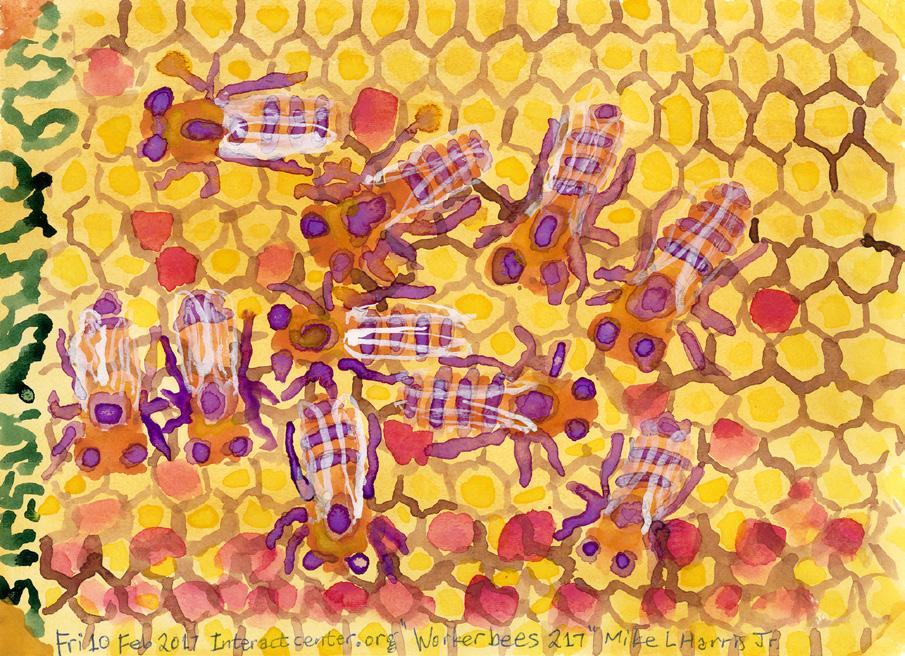

This collection highlights the important work of artists who create beautiful and scientifically accurate depictions of plants and animals found at the Arboretum.
ANDERSEN
HORTICULTURAL LIBRARY
Petals and Poetry: A Floral Journey Through the Works of Shakespeare
Through March 1, 2024
Celebrate the 400th anniversary of Shakespeare’s First Folio by viewing works from the library's collection that bring to life the enchanting world of William Shakespeare's flora and fauna. Experience the playwright's natural surroundings by exploring the captivating creatures, delicate blooms and lush foliage that inspired his poetic imagery.
“Worker Bees” by Mike Harris (top) and "Owls" by Daniel Metchnek (bottom) from "Rooted in Nature," opening Oct. 19.










































